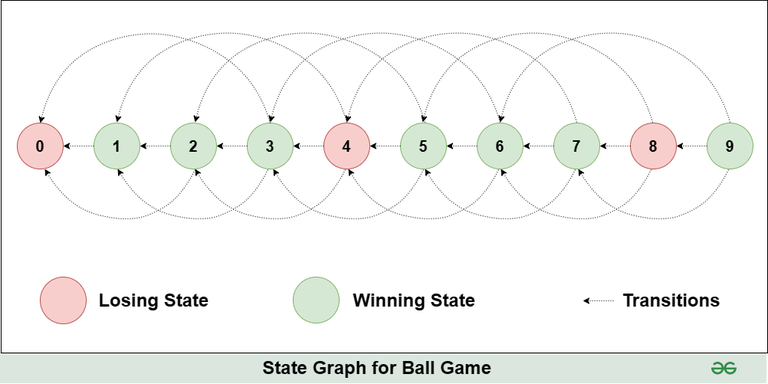Winning and Losing States for Competitive Programming
Last Updated :
07 Feb, 2024
In Competitive Programming, we often encounter problems where two players are playing a game optimally and we need to find the winner of the game. In order to solve such problems, we should have a clear understanding of Winning and Losing states of the game. In this article, we will go through the basics of Winning and Losing States and how to identify them using State Graph.

Understanding Winning and Losing States:
In any game-based problem, we can classify all possible states into two categories: winning states and losing states.
- A winning state is a state from which the player can ensure a win by playing optimally.
- A losing state is a state where the player will inevitably lose if the opponent plays optimally.
The classification of states into winning and losing is based on the concept of optimality. If a player can make a move that leads to a losing state for the opponent, then the current state is considered a winning state. Conversely, if all moves from the current state lead to winning states for the opponent, then the current state is a losing state.
The process of classifying states begins with the identification of obvious losing states. In most cases, these are states where no moves are possible. For instance, in a game where players take turns removing balls from a heap, a state with zero balls is a losing state because the player cannot make a move.
Once the losing states are identified, we can determine the winning states by finding states that can reach a losing state in one move. This process continues until all states are classified as either winning or losing.
What is a State Graph?
A state graph of a game is a directed graph of nodes, where each node represents a state in the game and transitions are represented in the form of directed edges. All the states of the game can be represented with the help of a state graph, where the node which does not have any outgoing edge states that there are no moves left after this state and the game ends here.
If all the outgoing edges from the current node(or state) leads to winning nodes, then this node is a losing node. Else if there is at least a single outgoing edge to a losing state, then the current state is a winning state.
Example of Winning and Losing States: The Ball Game
Consider a game where players alternately remove 1, 2, or 3 balls from a heap. The player who removes the last ball wins the game. In this game, a state with 0 balls is a losing state because no moves can be made. States with 1, 2, or 3 balls are winning states because the player can remove all remaining balls and win the game. However, a state with 4 balls is a losing state again because any move will leave a winning state for the opponent.
By continuing this process, we can classify all states. For example, the states from 0 to 9 can be classified as follows (W denotes a winning state and L denotes a losing state):
|
L
|
W
|
W
|
W
|
L
|
W
|
W
|
W
|
L
|
W
|
|
0
|
1
|
2
|
3
|
4
|
5
|
6
|
7
|
8
|
9
|
From this classification, we can derive an optimal strategy: always leave a number of balls that is divisible by 4. This strategy ensures that the opponent is always left with a losing state, provided that the initial number of balls is not divisible by 4.
State graph for the Ball Game:
Below is the state graph with states numbered from 0 to 9 and arrows representing the transitions from one state to another. For every node with value V, we can move to 3 different nodes with values: V – 1, V – 2 and V – 3.

From the above image, we can clearly see that the state with all outgoing edges to winning states is a losing state. Similarly, all the states which have at least one outgoing edge to losing state is a winning state.
Understanding winning and losing states is a powerful tool in competitive programming, enabling programmers to solve complex game-based problems by breaking them down into simpler, manageable states. By classifying these states and devising strategies based on this classification, programmers can ensure optimal gameplay and secure a win. However, it’s important to remember that the effectiveness of this approach depends on the ability to play optimally and predict the opponent’s optimal moves.
Share your thoughts in the comments
Please Login to comment...